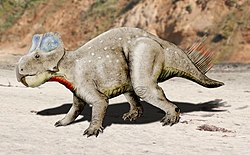Dinosaur finds
Ceratopsians
Color key
| Notes Uncertain or tentative taxa are in small text; |
| Genus | Species | Location | Member | Material | Notes | Images |
|---|---|---|---|---|---|---|
| Sinoceratops | S. zhuchengensis | N/A | N/A | Partial skull, including the braincase. | First ceratopsid dinosaur discovered outside of North America. |  |
| Zhuchengceratops | Z. inexpectus | N/A | N/A | Partial articulated skeleton including vertebrae, ribs, teeth, and parts of the skull and mandibles. |  | |
| Ischioceratops | I. zhuchengensis | N/A | N/A | Partially articulated specimen comprising the entire sacrum, a few ossified tendons, both halves of the pelvis, the anteriormost 15 caudal vertebrae in an articulated series, and the right femur, tibia and fibula. |  |
Ornithopods
Color key
| Notes Uncertain or tentative taxa are in small text; |
| Genus | Species | Location | Member | Material | Notes | Images |
|---|---|---|---|---|---|---|
S. giganteus | N/A | N/A | A fairly complete skeleton. | An edmontosaurin saurolophine hadrosaur that is among the largest ornithischians ever to exist, measuring 14.7 meters (48 ft) to 16.6 meters (54 ft) in length. A large hole near its nostrils may have been covered by a loose flap, which could be inflated to make sounds. |  |
Sauropods
Color key
| Notes Uncertain or tentative taxa are in small text; |
| Genus | Species | Location | Member | Material | Notes | Images |
|---|---|---|---|---|---|---|
Z. zangjiazhuangensis | Shandong, China | Wangshi Series | A single humurus | A saltasaurid sauropod | ||
Theropods
Color key
| Notes Uncertain or tentative taxa are in small text; |
| Genus | Species | Location | Member | Material | Notes | Images |
|---|---|---|---|---|---|---|
Z. magnus | Shandong, China | Wangshi Series | A partial skull | A tyrannosaurine tyrannosaurid about the size of Tarbosaurus . Zhuchengtyrannus can be distinguished from all other tyrannosaurines by a single autapomorphy, the presence of a horizontal shelf on the lateral surface of the base of the ascending process of the maxilla, and a rounded notch in the anterior margin of the maxillary fenestra. Zhuchengtyrannus also possesses a ventral margin of the antorbital fenestra that lies well above that of the ventral rim of the antorbital fossa. Additionally, the total length of the maxillary fenestra is more than half the distance between the anterior margins of the antorbital fossa and fenestra. Unlike the contemporaneous Tarbosaurus , Zhuchengtyrannus lacks a subcutaneous flange on the posterodorsal part of the jugal ramus of the maxilla, and a ventrally convex palatal shelf that covers the bulges of the roots of the rear teeth in medial view. |  | |
| Tyrannosaurus zhuchengensis | T. zhuchengensis | N/A | N/A | Synonym of Zhuchengtyrannus. | ||
| Anomalipes | A. zhaoi | Wangshi Series | An incomplete left hind-limb, including a partial left thigh, shin and shank, a complete metatarsal III and two toe bones | A Caenagnathid oviraptorosaurian. |
Thyreophorans
Color key
| Notes Uncertain or tentative taxa are in small text; |
| Genus | Species | Location | Member | Material | Notes | Images |
|---|---|---|---|---|---|---|
| Sinankylosaurus | S. zhuchengensis | Wangshi Series | An ilium | |||
| Ankylosauria ident. |
Reptilia
| Genus | Species | Location | Member | Material | Notes | Images |
|---|---|---|---|---|---|---|
| Crocodylia ident. | ||||||
| Testudinata ident. |